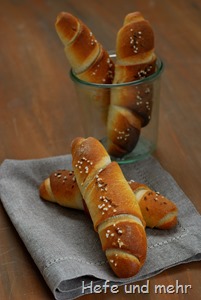 Another wish for the Bread Baking Course was Baguette. And Baguette dough is a simple dough: You need just flour, water, yeast and salt.
Another wish for the Bread Baking Course was Baguette. And Baguette dough is a simple dough: You need just flour, water, yeast and salt.
But when it comes to forming and slashing, it gets way more complicated. Only one thing can help with this: Practice! For slashing you actually don’t have to even bake baguette, one can start practicing with paper and pen! As PIP onces wrote: “If you can draw them, you can slash them!” And so I made two practice sheets for you. One with reference lines and one without. You can print them and start practising right away. Try to draw the slashes on the “Paper baguette” in fluent movements without stopping while drawing a slash. Repeat this until you feel comfortable with drawing the slashes, then try it with the real one. And other ways then the traditional cuts are possible as well. In France I saw Baguettes slashed lengthwise as well!

 There are three different ways to soak seeds or flour: You can either cook them, or soak them in hot water or in cold water. For this bread I decided to soak the seeds in cold water. They do not absorb not as much water as when hot water is used, and this results in seeds which have still some bite. As the seeds have to soak overnight some salt is added to prevent them from fermenting.
There are three different ways to soak seeds or flour: You can either cook them, or soak them in hot water or in cold water. For this bread I decided to soak the seeds in cold water. They do not absorb not as much water as when hot water is used, and this results in seeds which have still some bite. As the seeds have to soak overnight some salt is added to prevent them from fermenting. Do you know this? You take a photograph, and another one, and another one. And nothing looks good. This Arabian flatbread, Chubz, is one of this cases. It is so … flat. After ten minutes of unsatisfying pictures my beloved one turn nervous and declared that bread and
Do you know this? You take a photograph, and another one, and another one. And nothing looks good. This Arabian flatbread, Chubz, is one of this cases. It is so … flat. After ten minutes of unsatisfying pictures my beloved one turn nervous and declared that bread and  “Eingenetztes Brot” would be Net-Bread if translated literally. But the origin from the word “eingenetzt” does not stem from the German “Netz” (net) but from “Nass”, which means “Wet”. And making the bread is wet indeed. The sticky dough is easiest to handle when hands and tools are really wet. When the bread is placed in the oven its surface is wet as well. This helps to create the shiny crust which is characteristic for this bread. To get the soft dough in the oven without accident, a so called “Schapf”, a kind of ladle, is used traditionally. Even in my rather big kitchen collection, there is no “Schapf” and so I used a small salad bowl instead. And this worked fine!
“Eingenetztes Brot” would be Net-Bread if translated literally. But the origin from the word “eingenetzt” does not stem from the German “Netz” (net) but from “Nass”, which means “Wet”. And making the bread is wet indeed. The sticky dough is easiest to handle when hands and tools are really wet. When the bread is placed in the oven its surface is wet as well. This helps to create the shiny crust which is characteristic for this bread. To get the soft dough in the oven without accident, a so called “Schapf”, a kind of ladle, is used traditionally. Even in my rather big kitchen collection, there is no “Schapf” and so I used a small salad bowl instead. And this worked fine!
 The new Sourdough is ready to bake our first sourdough bread. As a freshly raised sourdough is still a little bit weak, it makes sense to do one (or even better two) sourdough feedings at warm temperature to
The new Sourdough is ready to bake our first sourdough bread. As a freshly raised sourdough is still a little bit weak, it makes sense to do one (or even better two) sourdough feedings at warm temperature to  There are a lot of whishes’ for recipes for the bread baking course: the swabian “genetzes” Bread, Baguette, Bread with heirloom grains, yeasted cake, Westphalian Farmer Loaf, Sourdough and Sourdough breads, Salzstangerl, Bagel and Basler Brot. And there are still my personal wishes, a whole grain bread and a multi grain bread. We are not running out of recipes or ideas 🙂
There are a lot of whishes’ for recipes for the bread baking course: the swabian “genetzes” Bread, Baguette, Bread with heirloom grains, yeasted cake, Westphalian Farmer Loaf, Sourdough and Sourdough breads, Salzstangerl, Bagel and Basler Brot. And there are still my personal wishes, a whole grain bread and a multi grain bread. We are not running out of recipes or ideas 🙂 So here is now the promised Spelt bread. I know that many of the readers of this blog like to bake with spelt, but baking with spelt flour is a little bit more challenging then baking with wheat flour, so the recipe comes relatively late in my bread baking course.
So here is now the promised Spelt bread. I know that many of the readers of this blog like to bake with spelt, but baking with spelt flour is a little bit more challenging then baking with wheat flour, so the recipe comes relatively late in my bread baking course.
